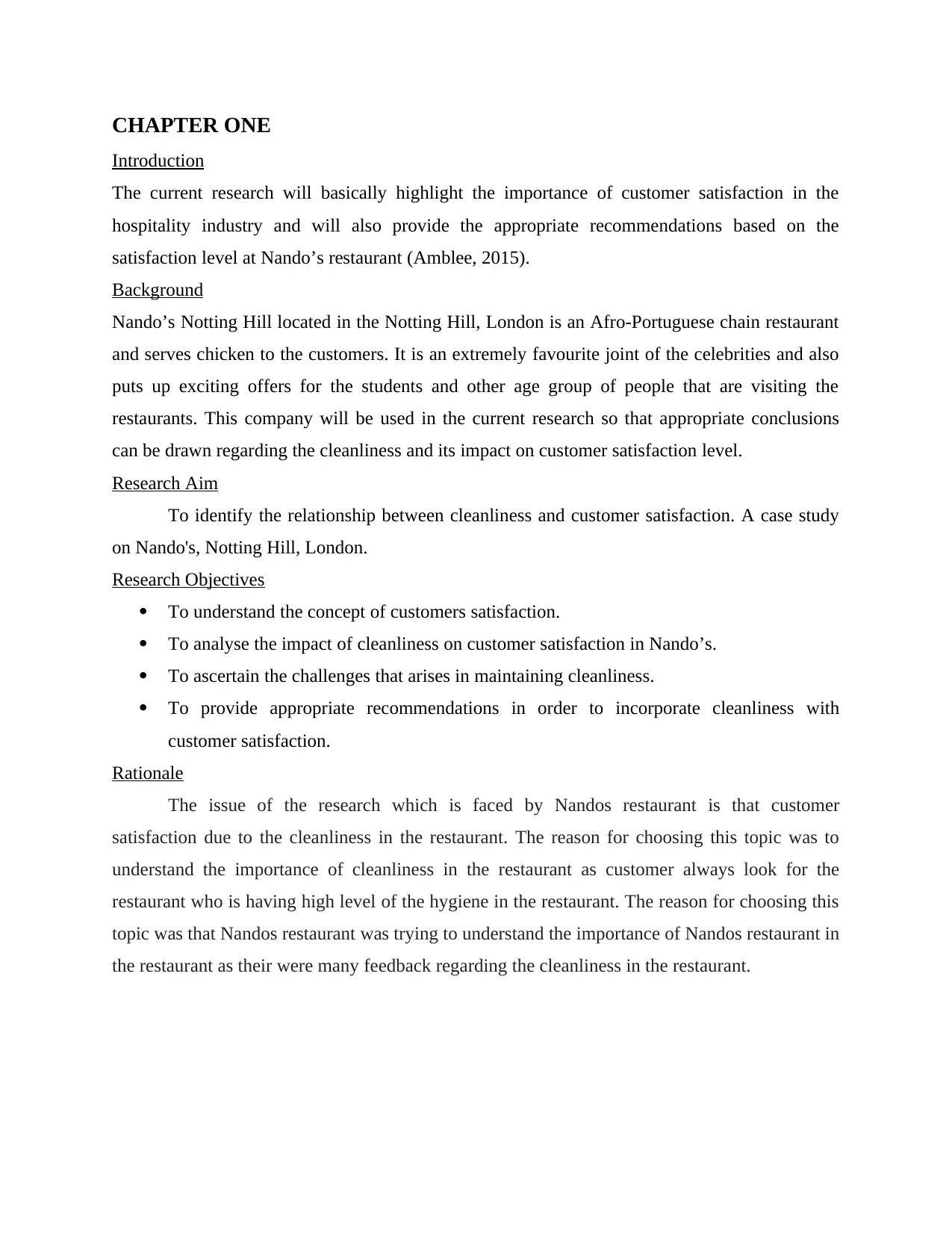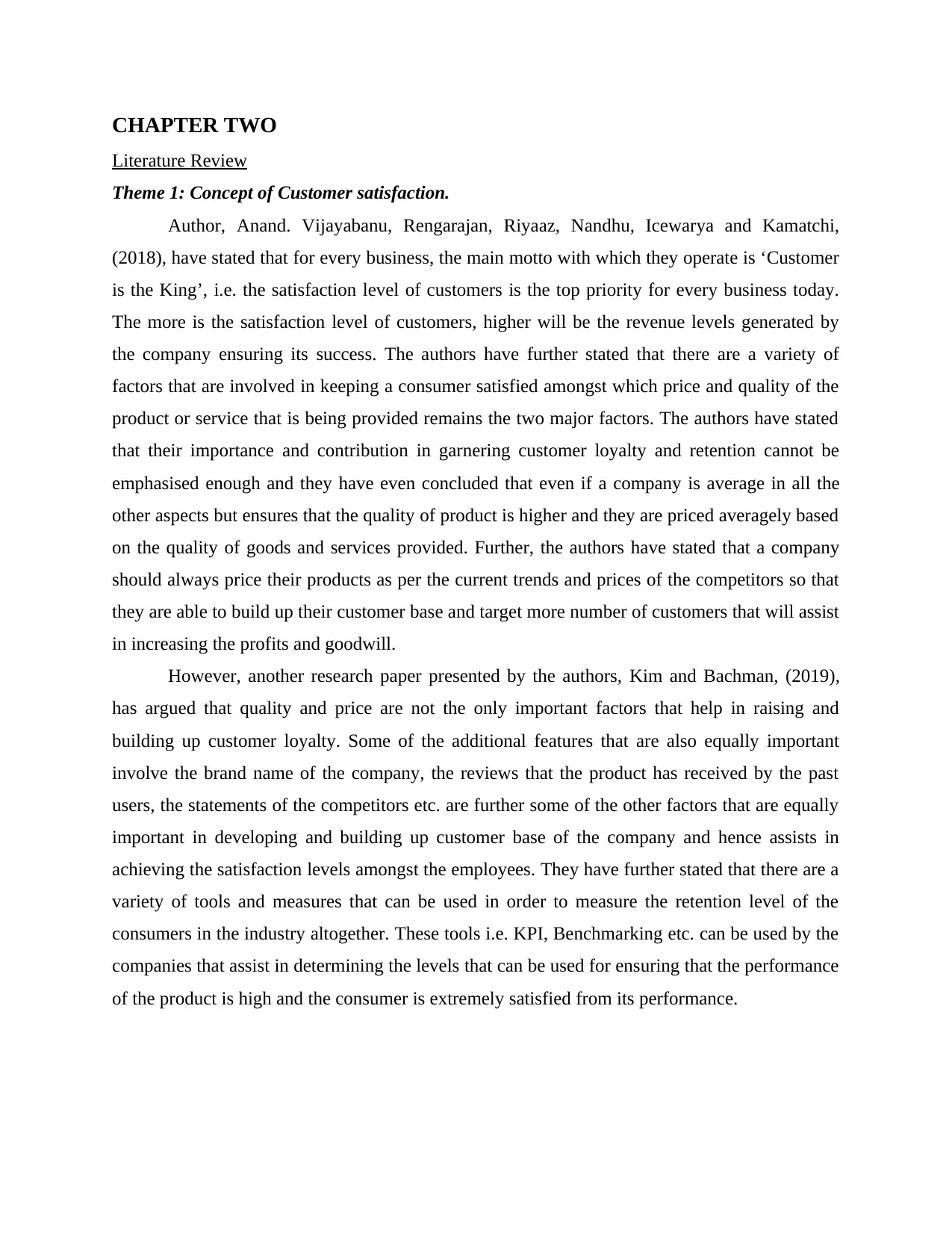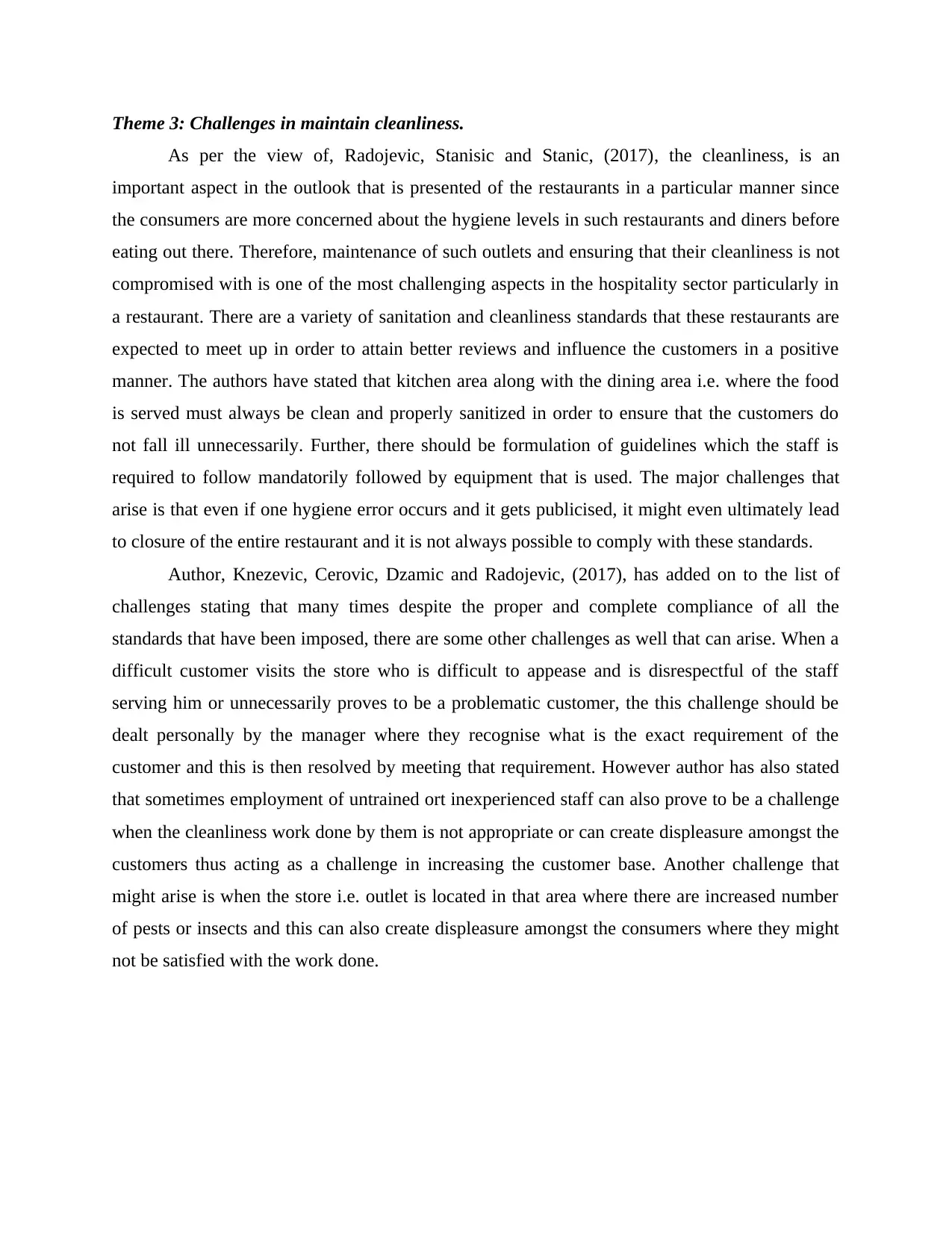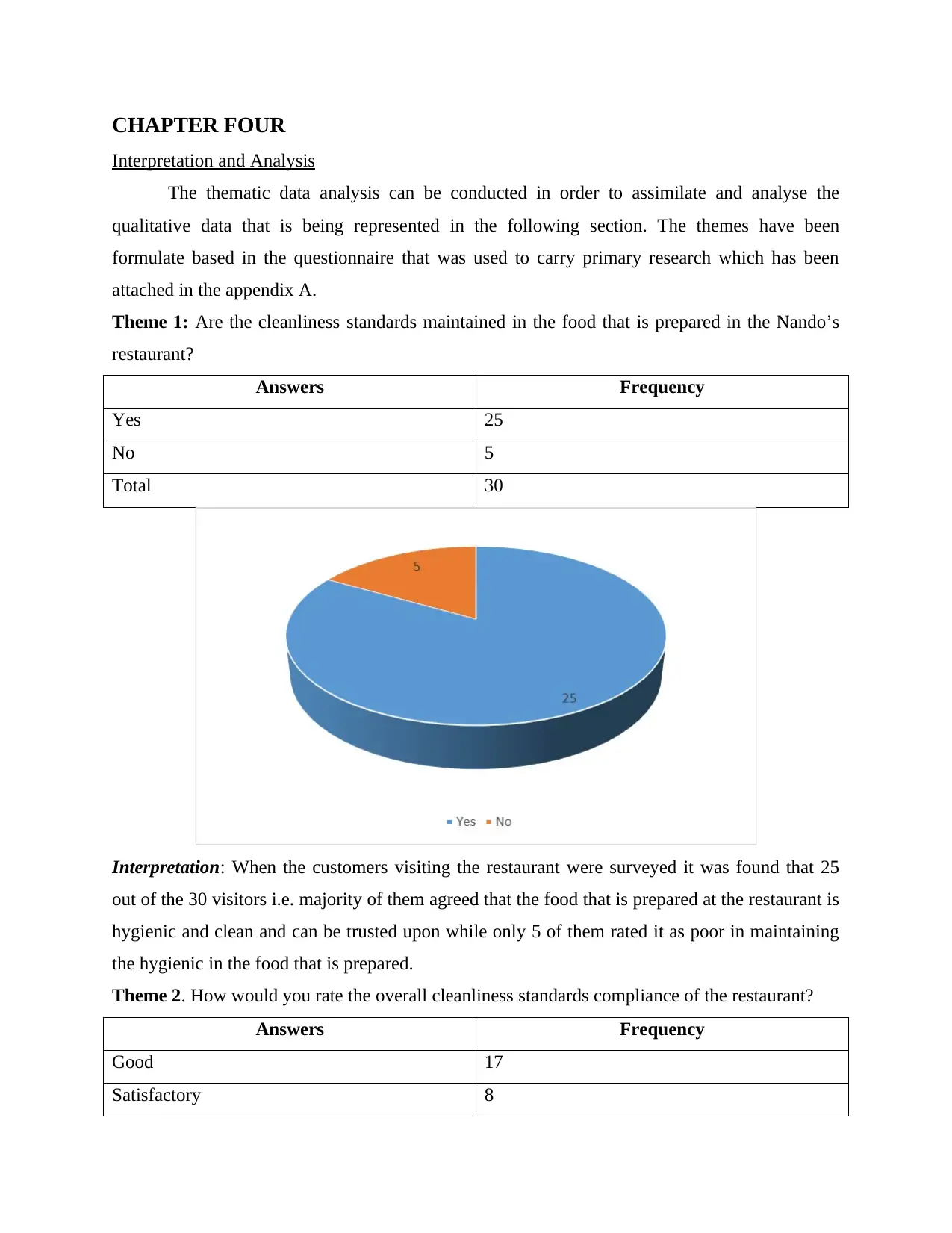Research Report: Customer Satisfaction and Cleanliness at Nando's
VerifiedAdded on 2023/01/19
|19
|4420
|46
Report
AI Summary
This research report investigates the relationship between cleanliness and customer satisfaction within the hospitality industry, using Nando's restaurant in Notting Hill, London, as a case study. The report explores the concept of customer satisfaction, analyzing how cleanliness impacts customer perception, loyalty, and overall satisfaction levels. It delves into the challenges faced in maintaining cleanliness, considering factors like staff training, pest control, and customer expectations. The literature review examines key themes such as the importance of cleanliness in restaurants, the factors influencing customer satisfaction, and the challenges of maintaining cleanliness. The research employs an inductive approach to explore these issues, culminating in recommendations for integrating cleanliness practices to enhance customer satisfaction, including employee presentation, hygiene standards, and consistent service. The report concludes with actionable insights to improve customer experience and loyalty.

RESEARCH PROJECTS
Paraphrase This Document
Need a fresh take? Get an instant paraphrase of this document with our AI Paraphraser

Abstract

Table of Contents
Abstract............................................................................................................................................2
Table of Contents.............................................................................................................................3
CHAPTER ONE..............................................................................................................................4
Introduction..................................................................................................................................4
Background..................................................................................................................................4
Research Aim...............................................................................................................................4
Research Objectives.....................................................................................................................4
Rationale......................................................................................................................................4
CHAPTER TWO.............................................................................................................................5
Literature Review........................................................................................................................5
CHAPTER THREE.........................................................................................................................9
Research Methodology................................................................................................................9
CHAPTER FOUR.........................................................................................................................11
Interpretation and Analysis........................................................................................................11
CHAPTER FIVE...........................................................................................................................16
Conclusion.................................................................................................................................16
Recommendations......................................................................................................................16
REFERENCES................................................................................................................................1
APPENDIX A..................................................................................................................................2
Abstract............................................................................................................................................2
Table of Contents.............................................................................................................................3
CHAPTER ONE..............................................................................................................................4
Introduction..................................................................................................................................4
Background..................................................................................................................................4
Research Aim...............................................................................................................................4
Research Objectives.....................................................................................................................4
Rationale......................................................................................................................................4
CHAPTER TWO.............................................................................................................................5
Literature Review........................................................................................................................5
CHAPTER THREE.........................................................................................................................9
Research Methodology................................................................................................................9
CHAPTER FOUR.........................................................................................................................11
Interpretation and Analysis........................................................................................................11
CHAPTER FIVE...........................................................................................................................16
Conclusion.................................................................................................................................16
Recommendations......................................................................................................................16
REFERENCES................................................................................................................................1
APPENDIX A..................................................................................................................................2
⊘ This is a preview!⊘
Do you want full access?
Subscribe today to unlock all pages.

Trusted by 1+ million students worldwide

CHAPTER ONE
Introduction
The current research will basically highlight the importance of customer satisfaction in the
hospitality industry and will also provide the appropriate recommendations based on the
satisfaction level at Nando’s restaurant (Amblee, 2015).
Background
Nando’s Notting Hill located in the Notting Hill, London is an Afro-Portuguese chain restaurant
and serves chicken to the customers. It is an extremely favourite joint of the celebrities and also
puts up exciting offers for the students and other age group of people that are visiting the
restaurants. This company will be used in the current research so that appropriate conclusions
can be drawn regarding the cleanliness and its impact on customer satisfaction level.
Research Aim
To identify the relationship between cleanliness and customer satisfaction. A case study
on Nando's, Notting Hill, London.
Research Objectives
To understand the concept of customers satisfaction.
To analyse the impact of cleanliness on customer satisfaction in Nando’s.
To ascertain the challenges that arises in maintaining cleanliness.
To provide appropriate recommendations in order to incorporate cleanliness with
customer satisfaction.
Rationale
The issue of the research which is faced by Nandos restaurant is that customer
satisfaction due to the cleanliness in the restaurant. The reason for choosing this topic was to
understand the importance of cleanliness in the restaurant as customer always look for the
restaurant who is having high level of the hygiene in the restaurant. The reason for choosing this
topic was that Nandos restaurant was trying to understand the importance of Nandos restaurant in
the restaurant as their were many feedback regarding the cleanliness in the restaurant.
Introduction
The current research will basically highlight the importance of customer satisfaction in the
hospitality industry and will also provide the appropriate recommendations based on the
satisfaction level at Nando’s restaurant (Amblee, 2015).
Background
Nando’s Notting Hill located in the Notting Hill, London is an Afro-Portuguese chain restaurant
and serves chicken to the customers. It is an extremely favourite joint of the celebrities and also
puts up exciting offers for the students and other age group of people that are visiting the
restaurants. This company will be used in the current research so that appropriate conclusions
can be drawn regarding the cleanliness and its impact on customer satisfaction level.
Research Aim
To identify the relationship between cleanliness and customer satisfaction. A case study
on Nando's, Notting Hill, London.
Research Objectives
To understand the concept of customers satisfaction.
To analyse the impact of cleanliness on customer satisfaction in Nando’s.
To ascertain the challenges that arises in maintaining cleanliness.
To provide appropriate recommendations in order to incorporate cleanliness with
customer satisfaction.
Rationale
The issue of the research which is faced by Nandos restaurant is that customer
satisfaction due to the cleanliness in the restaurant. The reason for choosing this topic was to
understand the importance of cleanliness in the restaurant as customer always look for the
restaurant who is having high level of the hygiene in the restaurant. The reason for choosing this
topic was that Nandos restaurant was trying to understand the importance of Nandos restaurant in
the restaurant as their were many feedback regarding the cleanliness in the restaurant.
Paraphrase This Document
Need a fresh take? Get an instant paraphrase of this document with our AI Paraphraser

CHAPTER TWO
Literature Review
Theme 1: Concept of Customer satisfaction.
Author, Anand. Vijayabanu, Rengarajan, Riyaaz, Nandhu, Icewarya and Kamatchi,
(2018), have stated that for every business, the main motto with which they operate is ‘Customer
is the King’, i.e. the satisfaction level of customers is the top priority for every business today.
The more is the satisfaction level of customers, higher will be the revenue levels generated by
the company ensuring its success. The authors have further stated that there are a variety of
factors that are involved in keeping a consumer satisfied amongst which price and quality of the
product or service that is being provided remains the two major factors. The authors have stated
that their importance and contribution in garnering customer loyalty and retention cannot be
emphasised enough and they have even concluded that even if a company is average in all the
other aspects but ensures that the quality of product is higher and they are priced averagely based
on the quality of goods and services provided. Further, the authors have stated that a company
should always price their products as per the current trends and prices of the competitors so that
they are able to build up their customer base and target more number of customers that will assist
in increasing the profits and goodwill.
However, another research paper presented by the authors, Kim and Bachman, (2019),
has argued that quality and price are not the only important factors that help in raising and
building up customer loyalty. Some of the additional features that are also equally important
involve the brand name of the company, the reviews that the product has received by the past
users, the statements of the competitors etc. are further some of the other factors that are equally
important in developing and building up customer base of the company and hence assists in
achieving the satisfaction levels amongst the employees. They have further stated that there are a
variety of tools and measures that can be used in order to measure the retention level of the
consumers in the industry altogether. These tools i.e. KPI, Benchmarking etc. can be used by the
companies that assist in determining the levels that can be used for ensuring that the performance
of the product is high and the consumer is extremely satisfied from its performance.
Literature Review
Theme 1: Concept of Customer satisfaction.
Author, Anand. Vijayabanu, Rengarajan, Riyaaz, Nandhu, Icewarya and Kamatchi,
(2018), have stated that for every business, the main motto with which they operate is ‘Customer
is the King’, i.e. the satisfaction level of customers is the top priority for every business today.
The more is the satisfaction level of customers, higher will be the revenue levels generated by
the company ensuring its success. The authors have further stated that there are a variety of
factors that are involved in keeping a consumer satisfied amongst which price and quality of the
product or service that is being provided remains the two major factors. The authors have stated
that their importance and contribution in garnering customer loyalty and retention cannot be
emphasised enough and they have even concluded that even if a company is average in all the
other aspects but ensures that the quality of product is higher and they are priced averagely based
on the quality of goods and services provided. Further, the authors have stated that a company
should always price their products as per the current trends and prices of the competitors so that
they are able to build up their customer base and target more number of customers that will assist
in increasing the profits and goodwill.
However, another research paper presented by the authors, Kim and Bachman, (2019),
has argued that quality and price are not the only important factors that help in raising and
building up customer loyalty. Some of the additional features that are also equally important
involve the brand name of the company, the reviews that the product has received by the past
users, the statements of the competitors etc. are further some of the other factors that are equally
important in developing and building up customer base of the company and hence assists in
achieving the satisfaction levels amongst the employees. They have further stated that there are a
variety of tools and measures that can be used in order to measure the retention level of the
consumers in the industry altogether. These tools i.e. KPI, Benchmarking etc. can be used by the
companies that assist in determining the levels that can be used for ensuring that the performance
of the product is high and the consumer is extremely satisfied from its performance.

Theme 2: Impact of cleanliness on satisfaction level of customer.
The authors, Tontini, Santos Bento, Milbratz, Volles and Ferrari, (2017), have stated that
cleanliness is an extremely important factor that adds to the contribution of a customer’s
satisfaction with the services provided by the customer. They have further stated that cleanliness
is an extremely important aspect in the fast food corners and junctions, restaurants, hotels,
hospitals and other similar industries categorised under the hospitality sector. Cleanliness is an
important factors for these industries since it assists in ensuring the consumers that whatever they
are consuming or wherever they are living, the place or product is healthy. The increase in the
percentage of health conscious people across the globe has acted as a major factor in improving
the sanitation and cleanliness level in the entire hospitality industry. Further, the authors
concluded that there is a positive relationship between the cleanliness level at the outlet of the
company and the pleasure, trust or prestige i.e. goodwill that the consumers associate with the
entire organisation. These factors ultimately are responsible for increasing the sales of the
company thus improving the revenue or earning and also enhancing the customer’s loyalty i.e.
the chances that consumers might return back to the store or outlet.
Another author, Mubeen, (2019), has however contradicted the above statement in their
research paper stating that although cleanliness and sanitation are undeniable one of the most
important factors in ensuring customers satisfaction and loyalty, however there are some other
aspects as well that should be taken into account while evaluating this factor. The authors have
argued that while measuring cleanliness, it is important to take into account what consumer’s
perceive about the cleanliness and sanitation at the store outlet. The author has stated that while
for some customers, the cleanliness refers to the interior of the outlet but for some it further
extends to the appearance and hygiene maintained by the server in the particular hospitality
sector. Further, the author concluded that personal hygiene, server’s hygiene and representation,
appearance of the interior including the restroom etc. are some of the additional factors that
companies should focus upon while expanding their customer base.
The authors, Tontini, Santos Bento, Milbratz, Volles and Ferrari, (2017), have stated that
cleanliness is an extremely important factor that adds to the contribution of a customer’s
satisfaction with the services provided by the customer. They have further stated that cleanliness
is an extremely important aspect in the fast food corners and junctions, restaurants, hotels,
hospitals and other similar industries categorised under the hospitality sector. Cleanliness is an
important factors for these industries since it assists in ensuring the consumers that whatever they
are consuming or wherever they are living, the place or product is healthy. The increase in the
percentage of health conscious people across the globe has acted as a major factor in improving
the sanitation and cleanliness level in the entire hospitality industry. Further, the authors
concluded that there is a positive relationship between the cleanliness level at the outlet of the
company and the pleasure, trust or prestige i.e. goodwill that the consumers associate with the
entire organisation. These factors ultimately are responsible for increasing the sales of the
company thus improving the revenue or earning and also enhancing the customer’s loyalty i.e.
the chances that consumers might return back to the store or outlet.
Another author, Mubeen, (2019), has however contradicted the above statement in their
research paper stating that although cleanliness and sanitation are undeniable one of the most
important factors in ensuring customers satisfaction and loyalty, however there are some other
aspects as well that should be taken into account while evaluating this factor. The authors have
argued that while measuring cleanliness, it is important to take into account what consumer’s
perceive about the cleanliness and sanitation at the store outlet. The author has stated that while
for some customers, the cleanliness refers to the interior of the outlet but for some it further
extends to the appearance and hygiene maintained by the server in the particular hospitality
sector. Further, the author concluded that personal hygiene, server’s hygiene and representation,
appearance of the interior including the restroom etc. are some of the additional factors that
companies should focus upon while expanding their customer base.
⊘ This is a preview!⊘
Do you want full access?
Subscribe today to unlock all pages.

Trusted by 1+ million students worldwide

Theme 3: Challenges in maintain cleanliness.
As per the view of, Radojevic, Stanisic and Stanic, (2017), the cleanliness, is an
important aspect in the outlook that is presented of the restaurants in a particular manner since
the consumers are more concerned about the hygiene levels in such restaurants and diners before
eating out there. Therefore, maintenance of such outlets and ensuring that their cleanliness is not
compromised with is one of the most challenging aspects in the hospitality sector particularly in
a restaurant. There are a variety of sanitation and cleanliness standards that these restaurants are
expected to meet up in order to attain better reviews and influence the customers in a positive
manner. The authors have stated that kitchen area along with the dining area i.e. where the food
is served must always be clean and properly sanitized in order to ensure that the customers do
not fall ill unnecessarily. Further, there should be formulation of guidelines which the staff is
required to follow mandatorily followed by equipment that is used. The major challenges that
arise is that even if one hygiene error occurs and it gets publicised, it might even ultimately lead
to closure of the entire restaurant and it is not always possible to comply with these standards.
Author, Knezevic, Cerovic, Dzamic and Radojevic, (2017), has added on to the list of
challenges stating that many times despite the proper and complete compliance of all the
standards that have been imposed, there are some other challenges as well that can arise. When a
difficult customer visits the store who is difficult to appease and is disrespectful of the staff
serving him or unnecessarily proves to be a problematic customer, the this challenge should be
dealt personally by the manager where they recognise what is the exact requirement of the
customer and this is then resolved by meeting that requirement. However author has also stated
that sometimes employment of untrained ort inexperienced staff can also prove to be a challenge
when the cleanliness work done by them is not appropriate or can create displeasure amongst the
customers thus acting as a challenge in increasing the customer base. Another challenge that
might arise is when the store i.e. outlet is located in that area where there are increased number
of pests or insects and this can also create displeasure amongst the consumers where they might
not be satisfied with the work done.
As per the view of, Radojevic, Stanisic and Stanic, (2017), the cleanliness, is an
important aspect in the outlook that is presented of the restaurants in a particular manner since
the consumers are more concerned about the hygiene levels in such restaurants and diners before
eating out there. Therefore, maintenance of such outlets and ensuring that their cleanliness is not
compromised with is one of the most challenging aspects in the hospitality sector particularly in
a restaurant. There are a variety of sanitation and cleanliness standards that these restaurants are
expected to meet up in order to attain better reviews and influence the customers in a positive
manner. The authors have stated that kitchen area along with the dining area i.e. where the food
is served must always be clean and properly sanitized in order to ensure that the customers do
not fall ill unnecessarily. Further, there should be formulation of guidelines which the staff is
required to follow mandatorily followed by equipment that is used. The major challenges that
arise is that even if one hygiene error occurs and it gets publicised, it might even ultimately lead
to closure of the entire restaurant and it is not always possible to comply with these standards.
Author, Knezevic, Cerovic, Dzamic and Radojevic, (2017), has added on to the list of
challenges stating that many times despite the proper and complete compliance of all the
standards that have been imposed, there are some other challenges as well that can arise. When a
difficult customer visits the store who is difficult to appease and is disrespectful of the staff
serving him or unnecessarily proves to be a problematic customer, the this challenge should be
dealt personally by the manager where they recognise what is the exact requirement of the
customer and this is then resolved by meeting that requirement. However author has also stated
that sometimes employment of untrained ort inexperienced staff can also prove to be a challenge
when the cleanliness work done by them is not appropriate or can create displeasure amongst the
customers thus acting as a challenge in increasing the customer base. Another challenge that
might arise is when the store i.e. outlet is located in that area where there are increased number
of pests or insects and this can also create displeasure amongst the consumers where they might
not be satisfied with the work done.
Paraphrase This Document
Need a fresh take? Get an instant paraphrase of this document with our AI Paraphraser

Theme 4: Recommendation on incorporation of cleanliness with customer satisfaction.
Author, Laurila, (2018), has stated that every organisation whether operating under
hospitality industry or not should integrate cleanliness practices in their activities. The authors
have presented a series of recommendations that can be implemented in the organisation so that
the satisfaction of employees can be integrated well with the cleanliness level maintained by the
employees can be used to generate the increases customer base. The authors state that an
employee or server should always be presentable and immaculately clean while serving to the
visitors in the dining area and the dust particles should not get accumulated in any place like in
the utensils, dishes, cutlery etc. Further, the linen and other cloth that is sued should be properly
washed and the serving waiters should be different from the ones that are cooking inside i.e. their
hands or clothes should not be dirty while serving. Apart from this, the authors also highlighted
the importance of behavioural tendencies and serving efficiency of the servers and waiters while
serving the customers and the manner of speaking i.e. the cleaner it is, more will be the
satisfaction and delight level of the consumers which will increase their chances of returning
back.
Another author, Godwin, (2015), has added in the recommendations where they have
addressed some additional aspects that can be used to achieve the cleanliness and sanitation
levels that are so desired by the customers. These involve, consistency in the manner in which
the customers are targeted and serviced and further, the levels of giving service should be never
compromised with. The authors also touched upon some of the other aspects that might
influenced the loyalty of the customers some of the prominent ones being the cultural practices
and its incorporation in cleanliness, technology’s integration etc. that are the rising needs of
current date practices in the organisation.
Author, Laurila, (2018), has stated that every organisation whether operating under
hospitality industry or not should integrate cleanliness practices in their activities. The authors
have presented a series of recommendations that can be implemented in the organisation so that
the satisfaction of employees can be integrated well with the cleanliness level maintained by the
employees can be used to generate the increases customer base. The authors state that an
employee or server should always be presentable and immaculately clean while serving to the
visitors in the dining area and the dust particles should not get accumulated in any place like in
the utensils, dishes, cutlery etc. Further, the linen and other cloth that is sued should be properly
washed and the serving waiters should be different from the ones that are cooking inside i.e. their
hands or clothes should not be dirty while serving. Apart from this, the authors also highlighted
the importance of behavioural tendencies and serving efficiency of the servers and waiters while
serving the customers and the manner of speaking i.e. the cleaner it is, more will be the
satisfaction and delight level of the consumers which will increase their chances of returning
back.
Another author, Godwin, (2015), has added in the recommendations where they have
addressed some additional aspects that can be used to achieve the cleanliness and sanitation
levels that are so desired by the customers. These involve, consistency in the manner in which
the customers are targeted and serviced and further, the levels of giving service should be never
compromised with. The authors also touched upon some of the other aspects that might
influenced the loyalty of the customers some of the prominent ones being the cultural practices
and its incorporation in cleanliness, technology’s integration etc. that are the rising needs of
current date practices in the organisation.

CHAPTER THREE
Research Methodology
Research Methodology is the collection of the different tool and technique which generally used
to identify, select, process and analyze information related to the topic of the research. Research
methodology defines the tool that are used or can be used to gather the relevant information
regarding the research study (Kumar, 2019). Research type, approach and philosophy are some
of the common research methodology tool and techniques.
Research Approach: Research approach is a plan and procedure which explain the different
assumption to detailed the method of the data collection. In the field of the research there are two
common type of the research approach which can be used by the research to demonstrate the
light on role of cleanliness in customer satisfaction. Inductive and deductive are two approach.
Inductive approach is the approach which looks to generate new theory on the basis of the data
which has been gathered in the research and deductive approach used to test the already made
theory. Researcher has used Inductive approach as this approach used to provide crucial hand for
the type of the research which had been selected that is Qualitative research (Litosseliti, ed.,
2018).
Research Philosophy: Research philosophy is a belief about the way in which data about a
phenomenon should be gathered, analyzed and used. Their are two type of the research
philosophy that is Interpretivism philosophy and positivism philosophy. Interpretivism
philosophy used to take the human interest into a study to find out the outcome of the research.
Positivism philosophy used to look at the information derived from the sensory experience,
interpreted through reason and logic. Researcher has used Interpretivism philosophy in the
research as it has helped the researcher in studying the human interest as well (Rahimi and
Kozak, 2017). This philosophy has also provide the crucial support for the type of research type
selected by the scholar to conduct the research on the topic “Cleanliness and its impact on
increasing consumer satisfaction”.
Research Onion: Research onion helps in determine the stages through which a researcher passes
while developing research methodology. In the present research, the researcher has used the
various approaches and research techniques etc. that have been detailed in the headings that have
been formulated in this chapter. The data has been collected in cross sectional level and missed
methods have been used where the researcher has carried out survey by filing questionnaires.
Research Methodology
Research Methodology is the collection of the different tool and technique which generally used
to identify, select, process and analyze information related to the topic of the research. Research
methodology defines the tool that are used or can be used to gather the relevant information
regarding the research study (Kumar, 2019). Research type, approach and philosophy are some
of the common research methodology tool and techniques.
Research Approach: Research approach is a plan and procedure which explain the different
assumption to detailed the method of the data collection. In the field of the research there are two
common type of the research approach which can be used by the research to demonstrate the
light on role of cleanliness in customer satisfaction. Inductive and deductive are two approach.
Inductive approach is the approach which looks to generate new theory on the basis of the data
which has been gathered in the research and deductive approach used to test the already made
theory. Researcher has used Inductive approach as this approach used to provide crucial hand for
the type of the research which had been selected that is Qualitative research (Litosseliti, ed.,
2018).
Research Philosophy: Research philosophy is a belief about the way in which data about a
phenomenon should be gathered, analyzed and used. Their are two type of the research
philosophy that is Interpretivism philosophy and positivism philosophy. Interpretivism
philosophy used to take the human interest into a study to find out the outcome of the research.
Positivism philosophy used to look at the information derived from the sensory experience,
interpreted through reason and logic. Researcher has used Interpretivism philosophy in the
research as it has helped the researcher in studying the human interest as well (Rahimi and
Kozak, 2017). This philosophy has also provide the crucial support for the type of research type
selected by the scholar to conduct the research on the topic “Cleanliness and its impact on
increasing consumer satisfaction”.
Research Onion: Research onion helps in determine the stages through which a researcher passes
while developing research methodology. In the present research, the researcher has used the
various approaches and research techniques etc. that have been detailed in the headings that have
been formulated in this chapter. The data has been collected in cross sectional level and missed
methods have been used where the researcher has carried out survey by filing questionnaires.
⊘ This is a preview!⊘
Do you want full access?
Subscribe today to unlock all pages.

Trusted by 1+ million students worldwide

The philosophy used is interpretivism and the approach is inductive that has been used by the
researcher (Quinlan and et.al., 2019).
Data Collection: Data collection is the process in which scholar used to collect the information
from the different source available. Their are mainly two type of the data collection tool through
which data is collected that is primary data collection tool and secondary data collection tool.
Primary data collection tool used to collect the data from the source itself whereas secondary
data collection used to collect the data from the source who have already collected the data.
Scholar has used both the tool to collect the data. Secondary data collection has been done with
the help of the different books and journal related to the topic of the research. Primary data has
been collected with the help of the survey which was conducted on the 30 visitor of Nando’s
restaurant. Survey will be conducted via Questionnaire which has mixture of open ended and
close ended questions (Zemke and et.al., 2015). Data which is collected are analysed by the
thematic data analysis tool by making different theme and graph of the data collected.
Sampling: Sampling is a process used in statistical analysis in which a predetermined number of
observations are taken from a larger population. There are two type of the sampling tool which
can be used by the scholar namely probabilistic and non-probabilistic. Probabilistic method used
to give equal chance to all the respondent to get selected in the cut of respondent (Liu and et.al.,
2017). Non probabilistic does not give equal opportunity for all the respondent to get selected in
the cut of respondent. Scholar has used simple random method under probabilistic method to
select the sample size for the research. 30 visitor of Nando’s restaurant has been selected as a
sample size for the research.
researcher (Quinlan and et.al., 2019).
Data Collection: Data collection is the process in which scholar used to collect the information
from the different source available. Their are mainly two type of the data collection tool through
which data is collected that is primary data collection tool and secondary data collection tool.
Primary data collection tool used to collect the data from the source itself whereas secondary
data collection used to collect the data from the source who have already collected the data.
Scholar has used both the tool to collect the data. Secondary data collection has been done with
the help of the different books and journal related to the topic of the research. Primary data has
been collected with the help of the survey which was conducted on the 30 visitor of Nando’s
restaurant. Survey will be conducted via Questionnaire which has mixture of open ended and
close ended questions (Zemke and et.al., 2015). Data which is collected are analysed by the
thematic data analysis tool by making different theme and graph of the data collected.
Sampling: Sampling is a process used in statistical analysis in which a predetermined number of
observations are taken from a larger population. There are two type of the sampling tool which
can be used by the scholar namely probabilistic and non-probabilistic. Probabilistic method used
to give equal chance to all the respondent to get selected in the cut of respondent (Liu and et.al.,
2017). Non probabilistic does not give equal opportunity for all the respondent to get selected in
the cut of respondent. Scholar has used simple random method under probabilistic method to
select the sample size for the research. 30 visitor of Nando’s restaurant has been selected as a
sample size for the research.
Paraphrase This Document
Need a fresh take? Get an instant paraphrase of this document with our AI Paraphraser

CHAPTER FOUR
Interpretation and Analysis
The thematic data analysis can be conducted in order to assimilate and analyse the
qualitative data that is being represented in the following section. The themes have been
formulate based in the questionnaire that was used to carry primary research which has been
attached in the appendix A.
Theme 1: Are the cleanliness standards maintained in the food that is prepared in the Nando’s
restaurant?
Answers Frequency
Yes 25
No 5
Total 30
Interpretation: When the customers visiting the restaurant were surveyed it was found that 25
out of the 30 visitors i.e. majority of them agreed that the food that is prepared at the restaurant is
hygienic and clean and can be trusted upon while only 5 of them rated it as poor in maintaining
the hygienic in the food that is prepared.
Theme 2. How would you rate the overall cleanliness standards compliance of the restaurant?
Answers Frequency
Good 17
Satisfactory 8
Interpretation and Analysis
The thematic data analysis can be conducted in order to assimilate and analyse the
qualitative data that is being represented in the following section. The themes have been
formulate based in the questionnaire that was used to carry primary research which has been
attached in the appendix A.
Theme 1: Are the cleanliness standards maintained in the food that is prepared in the Nando’s
restaurant?
Answers Frequency
Yes 25
No 5
Total 30
Interpretation: When the customers visiting the restaurant were surveyed it was found that 25
out of the 30 visitors i.e. majority of them agreed that the food that is prepared at the restaurant is
hygienic and clean and can be trusted upon while only 5 of them rated it as poor in maintaining
the hygienic in the food that is prepared.
Theme 2. How would you rate the overall cleanliness standards compliance of the restaurant?
Answers Frequency
Good 17
Satisfactory 8

Poor 5
Total 30
Interpretation: It can be interpreted form the chart above that while evaluating the compliance of
the quality standards of the restaurant it was found that majority of them i.e. 17 out of 30 voted
that compliance was good while 8 out of 30 respondents rated as satisfactory and only 5 out of
the 30 of them rated the services as poor.
Theme 3. Has the visitor’s percentage increased or decreased in the past years at the Nando’s?
Answers Frequency
Strongly increased 13
Increased 8
Neutral 5
Strongly decreased 0
Decreased 4
Total 30
Total 30
Interpretation: It can be interpreted form the chart above that while evaluating the compliance of
the quality standards of the restaurant it was found that majority of them i.e. 17 out of 30 voted
that compliance was good while 8 out of 30 respondents rated as satisfactory and only 5 out of
the 30 of them rated the services as poor.
Theme 3. Has the visitor’s percentage increased or decreased in the past years at the Nando’s?
Answers Frequency
Strongly increased 13
Increased 8
Neutral 5
Strongly decreased 0
Decreased 4
Total 30
⊘ This is a preview!⊘
Do you want full access?
Subscribe today to unlock all pages.

Trusted by 1+ million students worldwide
1 out of 19
Related Documents
Your All-in-One AI-Powered Toolkit for Academic Success.
+13062052269
info@desklib.com
Available 24*7 on WhatsApp / Email
![[object Object]](/_next/static/media/star-bottom.7253800d.svg)
Unlock your academic potential
Copyright © 2020–2025 A2Z Services. All Rights Reserved. Developed and managed by ZUCOL.





